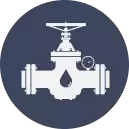Many fluid systems have valves as critical components. They regulate the flow of liquids and gases as well as their pressure. Whether keeping processes safe and efficient in homes, industries, or high-tech systems, valves are indispensable.
Types of Valves
There are various types of valves, each of which serves a specific purpose.
Ball Valves
Ball valves contain a ball with a hole through it. As the ball turns, the hole aligns with the pipe to allow fluid through or blocks it when turned back. They are uncomplicated, dependable, and perform beautifully under high pressure.
Gate Valves
A type of valve which uses a flat disc or a gate that moves up or down. With the gate open, fluid flows with little resistance. The main advantage of a butterfly valve is that it permits a gross amount of fluid to go through easily; therefore, they are frequently used in water features and pipelines.
Globe Valves
These valve types use a moveable disk or plug where the closure element disc sits on a fixed ring. This design makes it possible to stabilize the flow very precisely. The valve is used in systems that require a lot of control of the fluid, as the flow through these valves can be changed very rapidly.
Butterfly Valves
Butterfly valves use a rotating disc that functions like a door to regulate the flow. They are small, straightforward to work with, and affordable. This type of valve is used in large water systems and HVAC (heating, ventilation, and air conditioning) devices, where space is limited.
Check Valves
Check valves only allow fluids to flow in one direction. Some of these are automatic valves that close when fluid is attempting to flow backward, which protects equipment such as pumps and compressors from damage.
Pressure Relief and Safety Valves
These valves guard systems against hazardous pressure levels. They passively open to vent excess pressure, protecting the system and preventing damage from an overpressure event.
Control Valves
The control valves are a common part of an automated systems. They modulate fluid flow, temperature and pressure on the fly. These valves interact with sensors and computer systems to make sure that operations stay at safe and efficient levels.
Applications of Valves
Many industries make use of valves. Valves solve different problems in different industries.
1. Industrial Manufacturing
In production, valves regulate raw material flow and production processes. They are present in systems such as cooling, lubrication, and production lines, making certain that machines operate effectively and quickly.
2. Oil and Gas
Valves are used within the oil and gas industry to control the flow of oil, gas, and other fluids. In this industry valves must withstand high pressure, high temperatures, and corrosive materials. They are crucial for safe extraction, refining and transport.
3. Water and Wastewater Management
Water treatment and distribution systems would be ineffective without valves. They also help control the flow of water, prevent contamination, and maintain water quality. Valves are likewise used in wastewater treatment plants to control the flow and treatment of wastewater.
4. HVAC Systems
Heating, ventilation, and air conditioning control refrigerants and a similar variety of liquids through valves. These valves play a crucial role in ensuring that homes and buildings are heated and cooled efficiently so they can remain comfortable and energy-efficient.
5. Power Generation
In power generation plants, valves modulate steam, cooling water, and fuel flow. They are critical to running the plant safely and efficiently, keeping fluids moving at the right pressure and temperature.
6. Food and Beverage
Valves are also utilized in the food and beverage sector but in a manner that conforms to strict hygiene standards. Cleaning of valves opposite this side and offset way of contamination in process of production.
7. Pharmaceuticals and Biotechnology
Valves in these sectors require high precision control for the transport of fluids including chemicals, active ingredients, and more. They are manufactured for the high standards of quality and safety needed in the medical and scientific fields.
Design and Material Considerations
The design and material selection is also critical in the manufacturing of valves that are sturdy and reliable. Here is a little background on the making of valves.
Material Selection
Different materials are used to make valves, according to their application. Common materials include:
- Stainless Steel: Durable and corrosion resistant but is best to use in harsh environments.
- Brass: Strong and usually used for water and gas lines.
- Cast Iron: Used in high-pressure systems, including industrial.
- Plastics and Composites: Made to be lightweight and chemical resistant, frequently used in water treatment or chemical processing.
Selecting the right material will help make sure the valve is durable and performs well in its intended environment.
Engineering and Innovation
Valves are modern results of many years of engineering. Later, modern tools like computer-aided design (CAD) create precise parts with less performance loss. With modern technologies such as automated control systems and smart valves, valves are becoming more efficient and reliable. These advances help decrease downtime and minimize maintenance expenses.
Advanced Technologies in Valves
With technology developing, valve functionality is also evolving. New features are making valves smarter, and more efficient.
Smart Valves and Automation
They have sensors for flow, pressure, and temperature. They transmit real-time data to control systems, enabling predictive maintenance. That way, issues can get fixed before they escalate, and systems can run smoothly, minimizing unplanned downtime.
Energy Efficiency and Sustainability
Newer valves are designed to consume less energy, generating less turbulence and optimizing fluid flow. That means they reduce energy consumption and reduce operating costs. Such designs will help promote better sustainability practices by becoming more waste-efficient and less environmentally impactful in their end-use.
Integration with IoT and Industry 4.0
Valve technology is the latest frontier in the Internet of Things. Valves are now often working alongside digital systems to assist operators in coming to informed decisions. The entire system becomes much more efficient in modern industrial environments as this integration allows for remote monitoring and control.
Maintenance, Reliability, and Lifespan
Valves are extremely durable, but need to be maintained regularly to function properly.
- Routine Maintenance: Regular checks and prevention can avert issues. Valves run well with cleaning, lubrication, and replacement where necessary. Regular maintenance reduces the risk of unforeseen breakdowns and prolongs the valve’s lifespan.
- Predictive Maintenance Techniques: Many modern valves are equipped with smart sensors that notify the operators when a fault is likely to occur. These sensors monitor wear and performance, so maintenance can be scheduled before breaking anything. It helps save time and lower this cost of repairs.
- Long-Term Reliability: Good maintained valve ensures long term reliability. Even in tough situations, a good valve will continue to perform its task effectively. Proper working valves are key to the safe and efficient operation of any system, which minimizes the costs associated with maintenance and downtime.
Benefits of High-Quality Valves
Investing in high-quality valves has many advantages. And this is how reputable valves provide those key benefits.
Improved Efficiency
Valves are vital in allowing the smooth flow of fluids and increasing the efficiency of systems. They can also drive down operational costs through energy loss reduction and pressure maintenance.
Enhanced Safety
Valves designed with safety in mind protect both equipment and personnel. The pressure-relief systems and check valves prevent overpressure and backflow, thereby reducing the risk of an incident.
Durability and Long Service Life
Good valves are better built and more thoughtfully designed so they last longer. They are more reliable for longer and requires less frequent replacement and down time for repairs resulting in lower overall costs.
Adaptability to Different Systems
There are some different kinds of valves that control everything from simple water flow to advanced automated systems, allowing industries to choose valves based on their exact needs.
Reduced Maintenance Costs
When valves are working well and have a long life, the need for frequent repairs is reduced. High-quality valves should always be preferred because their maintenance cost is low for long term work.
Environmental Benefits
Well-performing valves ensure optimal energy usage and waste reduction. Designed for longevity, they help minimize waste, making for lower-impact choices.
Future Trends in Valve Technology
Dynamism is the nature of the valve world. New trends and technologies will only bring performance here to the above levels over time.
Digital Integration and Smart Features
Digital systems and valves are becoming tightly coupled. It allows for better tracking, and management resulting in better maintenance. But even more valves will have smart features and capable of optimizing performance in real time.
Material Innovations
New materials and improved manufacturing flows are expected to make valves further lighter and stronger. Such innovations will lead to valves performing up to perform even under the intense conditions and enhance their durability.
Advanced Automation
With the growth of automation, valves will become increasingly prominent in self-regulating systems. Valves in the future will not only have all this technology inside them, they may be able to adjust themselves without any human intervention.
Customization and Modularity
The future of valves might even include more customization. Modular designs would enable easy adaptation of valves to different systems. This variability scalability will allow industries to serve their needs more effectively.
Conclusion
Valves are made as one of the key components to allow safe and efficient fluid control in a variety of applications. The design, quality, and sophisticated features of these systems will help make certain that the systems can withstand the rigors of contemporary industry and technology. The temperature of innovation is constantly rising and valves will be at the core of operational excellence performance and sustainability for decades to come.








